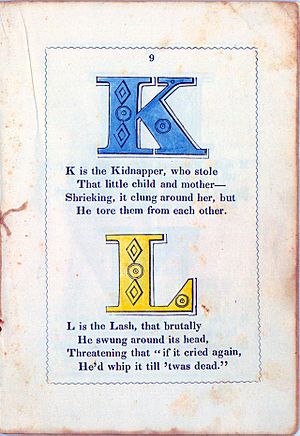The Anti-Slavery Alphabet facts for kids

Front cover
|
|
| Authors | Hannah Townsend and Mary Townsend |
|---|---|
| Country | United States |
| Language | English |
| Subject | Alphabet book |
| Publisher | Philadelphia Female Anti-Slavery Society |
|
Publication date
|
1846 |
| Media type | |
The Anti-Slavery Alphabet is a special alphabet book from 1846. It was created by the Philadelphia Female Anti-Slavery Society. This group worked to end slavery. The book was written by Hannah and Mary Townsend. They wanted to teach young children about why slavery was wrong. They hoped to encourage kids to support the movement to free enslaved people.
The Story Behind the Book
The Philadelphia Female Anti-Slavery Society was a local part of a bigger group. This bigger group was called the American Anti-Slavery Society. It was a national organization that fought against slavery. Both the main group and its local chapters made many books and writings. These materials were for both adults and children.
The Anti-Slavery Alphabet was first shown in December 1846. This was at the society's yearly Anti-Slavery Fair. The names of the authors were not on the book's cover. Later, people learned they were two Quaker women. Their names were Hannah Townsend (1812–1851) and her younger sister Mary Townsend (1814–1851). The sisters wrote the words for the book. They also designed the woodcut pictures for each letter. The book was made for young children. These children usually lived in homes where parents already wanted to end slavery.
A company in Philadelphia, Merrihew and Thompson, printed the book. It had 16 pages, with pictures and words on one side of each page. Workers then sewed the pages into the covers by hand. They also colored the pictures in each book by hand.
What's Inside the Book?
The book begins with a poem called "To Our Little Readers." This poem asks young readers to talk to others about ending slavery. It also tells them not to eat foods made with sugar. Sugar was often made on large farms called plantations. Enslaved people were forced to work on these plantations.
The main part of the book has two decorated capital letters on each page. These letters follow the normal English alphabet order. After each letter, there is a short poem with four lines, called a quatrain. This poem talks about a word that starts with that letter. For example, for the letter "A," the poem says:
A is an Abolitionist—
A man who wants to free
The wretched slave—and give to all
An equal liberty.
These short poems teach readers about ideas against slavery. They also show the problems with how enslaved people were treated in the United States. For example, the book talks about enslaved people being whipped. It also mentions children being taken away from their mothers.
Learn More
- The Slave's Friend, another anti-slavery magazine made for children


